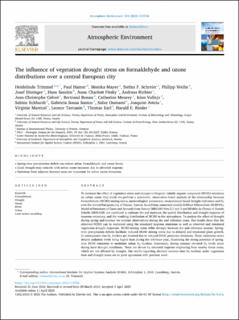| dc.contributor.author | Trimmel, Heidelinde | |
| dc.contributor.author | Hamer, Paul David | |
| dc.contributor.author | Mayer, Monika | |
| dc.contributor.author | Schreier, Stefan F. | |
| dc.contributor.author | Weihs, Philipp | |
| dc.contributor.author | Eitzinger, Josef | |
| dc.contributor.author | Sandén, Hans | |
| dc.contributor.author | Fitzky, Anne Charlott | |
| dc.contributor.author | Richter, Andreas | |
| dc.contributor.author | Calvet, Jean-Christophe | |
| dc.contributor.author | Bonan, Bertrand | |
| dc.contributor.author | Meurey, Catherine | |
| dc.contributor.author | Vallejo, Islen | |
| dc.contributor.author | Eckhardt, Sabine | |
| dc.contributor.author | Sousa Santos, Gabriela | |
| dc.contributor.author | Oumami, Safae | |
| dc.contributor.author | Arteta, Joaquim | |
| dc.contributor.author | Marécal, Virginie | |
| dc.contributor.author | Tarrasón, Leonor | |
| dc.contributor.author | Karl, Thomas | |
| dc.contributor.author | Rieder, Harald E. | |
| dc.date.accessioned | 2023-05-08T09:08:26Z | |
| dc.date.available | 2023-05-08T09:08:26Z | |
| dc.date.created | 2023-04-25T10:14:44Z | |
| dc.date.issued | 2023 | |
| dc.identifier.citation | Atmospheric Environment. 2023, 304, 119768. | en_US |
| dc.identifier.issn | 1352-2310 | |
| dc.identifier.uri | https://hdl.handle.net/11250/3066713 | |
| dc.description.abstract | To estimate the effect of vegetation stress and changes in biogenic volatile organic compound (BVOC) emissions on urban ozone (O3) levels we perform a systematic, observation-based analysis of the relationship between formaldehyde (HCHO) mixing ratios, meteorological parameters, measurement-based drought indicators and O3 over the central European city of Vienna, Austria. In addition, numerical models SURface EXternalisée (SURFEX), Model of Emissions of Gases and Aerosols from Nature (MEGAN) Vers.2.1 and 3 and MOdèle de Chimie A Grande Echelle (MOCAGE) are combined to estimate the soil moisture, the spatial distribution and drought response of isoprene emissions, and the resulting distribution of HCHO in the atmosphere. To analyse the effect of drought during spring and summer we contrast observations during dry and reference years. Our results show that the observed HCHO can be explained using the simulated isoprene emissions as well as observed and simulated vegetation drought responses. HCHO mixing ratios differ strongly between dry and reference seasons. Spring-time precipitation deficits facilitate reduced HCHO mixing ratios due to delayed and weakened plant growth. In consequence also O3 burdens are lowered due to reduced BVOC precursor emissions. These reductions occur despite radiation levels being higher than during the reference year, illustrating the strong potential of spring-time BVOC emissions to modulate urban O3 burdens. Conversely, during summer elevated O3 levels occur during local drought conditions. These are driven by advected isoprene originating from nearby forest areas, which are not affected by drought. Our results regarding elevated summer-time O3 burdens under vegetation heat and drought stress are in good agreement with previous work. | en_US |
| dc.language.iso | eng | en_US |
| dc.rights | Navngivelse 4.0 Internasjonal | * |
| dc.rights.uri | http://creativecommons.org/licenses/by/4.0/deed.no | * |
| dc.title | The influence of vegetation drought stress on formaldehyde and ozone distributions over a central European city | en_US |
| dc.title.alternative | The influence of vegetation drought stress on formaldehyde and ozone distributions over a central European city | en_US |
| dc.type | Peer reviewed | en_US |
| dc.type | Journal article | en_US |
| dc.description.version | publishedVersion | en_US |
| dc.rights.holder | © 2023 The Authors. Published by Elsevier Ltd. | en_US |
| dc.source.volume | 304 | en_US |
| dc.source.journal | Atmospheric Environment | en_US |
| dc.identifier.doi | 10.1016/j.atmosenv.2023.119768 | |
| dc.identifier.cristin | 2143118 | |
| dc.relation.project | EC/H2020/101004318 | en_US |
| dc.source.articlenumber | 119768 | en_US |
| cristin.ispublished | true | |
| cristin.fulltext | original | |
| cristin.qualitycode | 1 | |

